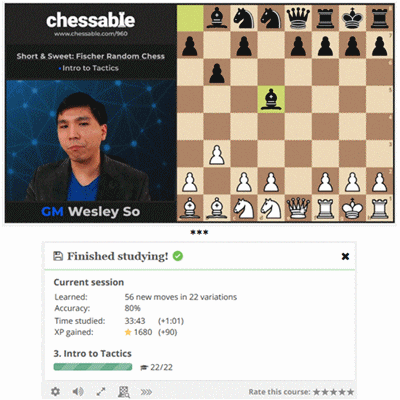In last month's post
Wesley So's Strategies
(December 2020), I located a pair of Chessable courses -- one of them pricey, the other free -- and finished saying,
I can't argue with 'Free', so I started the [Chessable] course and hope to have more to say in a followup post.
I hadn't accessed Chessable since writing that post, but had no trouble finding the course again. After signing in, I received the following screen.

Using that as a start point, I accessed the course, repeated the first chapter '1. Introduction' to get my bearings, and started on '2. Wesley So vs. Magnus Carlsen'. That second chapter is an hour-long video presented by GM Wesley So, where he discusses the third game from his FWFRCC final match with GM Carlsen (see my previous post for more about the match).
The third game of the match used SP729 RKNBBQNR as the start position. Before making his first move, So offered a preliminary analysis:-
Looks at first to be a very peculiar position, because the White King is far inside the Queenside and there are no less than five pieces blocking his way if he ever wants to castle Kingside to g1. So he has to move five pieces away from the back rank before he is able to castle [O-O].
The King feels a little bit vulnerable being so far away from the Queen. All the squares in front of the White King are protected for the time being. However he doesn't feel as safe as in other starting positions because the White Queen is so far away.
Other than that the other pieces are pretty much in regular starting positions, the difference being with the Bishops in the center so it's not clear exactly which direction they should go.
I split that analysis into three paragraphs, because they serve as a useful checklist for a generic analysis of any start position:-
- Consider the castling options
- Weigh the King's safety
- Note the position of the other pieces
The focus on the start distance between the King and the Queen was a new consideration for me, but the rest was familiar ground. One imprecision I noted was: 'All the squares in front of the White King are protected'. If we count the King as a protector, this is true of every start position. If we don't count the King, the g-Pawn in SP729 is not protected.
After his introduction, So said,
I played the move 1.e2-e4, which in my view is the best move in the position.
He then went on to explain why he thought it was best, also considering other reasonable first moves. In the first half of the video, GM So discussed the first dozen moves of the game (out of 60 played), providing some astute observations on the evolution of the play. Although I didn't watch the second half, I assume that it was equally instructive, given
(1) that a chess960 game eventually comes to resemble any game stemming from SP518 RNBQKBNR, the traditional start position; and
(2) So's status as one of the best SP518 players in the world.
A forum discussion is attached to the course. One comment, titled 'So lazy', said,
Come on, this is sooo lazy. It's just the most basic explanation of rules and some not Fischer Random only tactics, nothing about strategy or any good principles.
Anyone agreeing with that comment is advised to stick with SP518. First learn the basics of traditional chess, after which GM So's commentary should make more sense.
Since winning the '2019 FWFRCC', crushing GM Carlsen in the final match, he is considered the no.1 chess960 player in the world. This video shows why. I am one step closer to shelling out the bucks for the full, pricier course.


